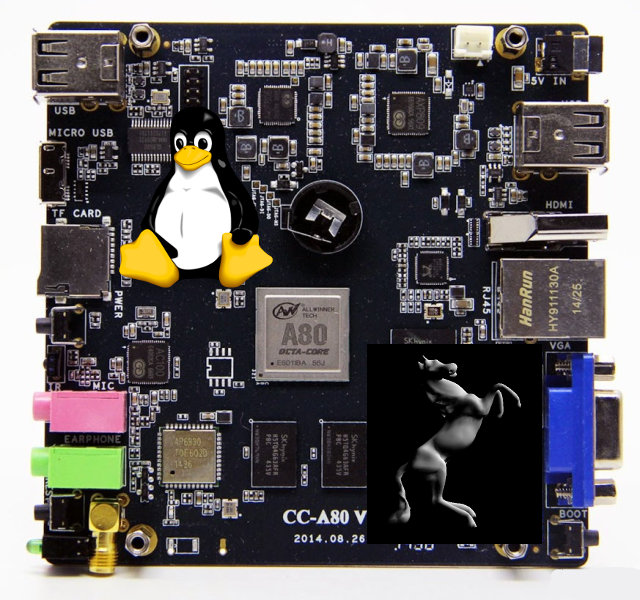Allwinner A80 is a powerful octa-core processor found in development boards and TV boxes such as Cubieboard4 or Tronsmart Draco AW80. Some early Ubuntu images and instructions had already been released for A80 Optimusboard and Draco AW80, but none of these featured GPU drivers for 3D acceleration, which to be honest, has limited advantages in Linux desktop distributions since desktop environments and most apps require full OpenGL support, i.e. not only OpenGL ES, and the only ARM SoC that can provide OpenGL support without external graphics card is Nvidia Tegra K1 SoC. Having said that GPU drivers would pave the way for smooth OpenELEC / Kodi user interface support in Allwinner A80 Linux distributions. That’s only one part of the puzzle, since the GPU normally handles the user interface, while the VPU takes care of video decoding.
 The good news is that CubieTech release updates images for their Cubieboard4 (CC-A80) development with PowerVR GC6200 GPU support, which you can download on Baidu:
The good news is that CubieTech release updates images for their Cubieboard4 (CC-A80) development with PowerVR GC6200 GPU support, which you can download on Baidu:
- linaro-cb4-emmc-vga-v0.3.img.7z is the eMMC flash image with VGA output
- linaro-cb4-emmc-hdmi-v0.3.img.7z.md5 is the eMMC flash image with HDMI output
The company also provided instructions they followed to create the image, using two files they got from Allwinner rogue_km.tar.gz , and discimage-release-1.4-fix_buffer_ideas_20141216_no_gl.tar.gz, available on Cubieboard server.
The steps below have been completed in an Ubuntu 14.04 computer’s terminal window, and may need some corrections, since I’ve mostly edited them from an email but not tried myself:
- Build drivers
123tar -zxpf rogue_km.tar.gzcp -rf rogue_km linux-3.4/modulescd rogue_km/build/linux/sunxi_linux && make -j4
The two drivers files dc_drmfbdev.ko and pvrsrvkm.ko can be found in linux-3.4/modules/rogue_km/binary_sunxi_linux_xorg_release/target_armhf directory - Copy drivers to SD card
You’ll need to download and extract Linaro Ubuntu 14.04 rootfs, and copy the drivers to a bootable sdcard in the rootfs partition
123<span lang="en-US">mkdir -p <path_to_rootfs>/lib/modules/3.4.3/extracp dc_drmfbdev.ko pvrsrvkm.ko <path_to_rootfs>/lib/modules/3.4.39/extra/sync </span> - Copy libraries to rootfs
123456789101112sudo tar -zxpf discimage-release-1.4-fix_buffer_ideas_20141216_no_gl.tar.gzcd <path_to_rootfs>/usr/local/pvrcp -rf etc/ <path_to_rootfs>/cp -rfd include share <path_to_rootfs>/usrcp -rfd lib/xorg <path_to_rootfs>/usr/libcp -rfd lib/* <path_to_rootfs>/usr/lib/arm-linux-gnueabihfcp -rf ssl <path_to_rootfs>/etccp -rf ssl/misc/ <path_to_rootfs>/usr/lib/sslcd discimage/usr/cp -rfd lib/* <path_to_rootfs>/usr/lib/arm-linux-gnueabihfcp -rf local/bin <path_to_rootfs>/usr/localsync - Insert the SD card into Cubieboard4 board, boot, and complete the steps as follows:
1234567mkdir -pv /usr/local/pvr/lib/dri/cd /usr/local/pvr/lib/dri/ln -s /usr/lib/arm-linux-gnueabihf/dri/pvr_dri.soln -s /usr/lib/arm-linux-gnueabihcdf/dri/swrast_dri.sorm /usr/lib/arm-linux-gnueabihf/mesa-egl -rfcd /usr/lib/arm-linux-gnueabihfln -s libGLESv2.so.1.4.3064661 libGLESv2.so.2
Edit /etc/modules to add the two lines:12dc_drmfbdevpvrsrvkm
Insert the modules, run depmod, and reboot to complete the installation:
1234insmod /lib/modules/3.4.39/extra/dc_drmfbdev.koinsmod /lib/modules/3.4.39/extra/depmodreboot
Done!
Now you can test 3D graphics acceleration works with glmark2-es2 or es2gears:
|
1 2 |
<span lang="en-US">sudo apt-get install glmark2-es2 sudo glmark2-es2 </span> |
Thanks to Ovidiu for the info.

Jean-Luc started CNX Software in 2010 as a part-time endeavor, before quitting his job as a software engineering manager, and starting to write daily news, and reviews full time later in 2011.
Support CNX Software! Donate via cryptocurrencies, become a Patron on Patreon, or purchase goods on Amazon or Aliexpress





What? PowerVR are notorious for never supporting Linux. How did this happen?
Probably a one off. I’m never buying anything PowerVR until they fix their Linux driver issues.
But having said that, funny how rockchip have yet to release anything for their Mali GPU.
Is Mali the new PowerVR?
well i have started to “harass” a bit one of my fellow alex voica who is reponsible for the PowerVr gpu Project at ImageTec 🙂
https://disqus.com/home/discussion/withimagination/allwinner_ultraocta_a80_processor_packs_a_powervr_series6_gpu_with_64_alu_cores/#comment-1768198705
more informations after my discussion with Alex Voica the PowerVr representative.
Call me what you want, but after 20yrs of using and developing for Linux, if the drivers aren’t upstreamed I don’t buy it. It’s not enough to have blobs or your distribution-of-choice package the drivers.
And just to put money where my mouth is, I recently ordered Meegopad T01 knowing I’m not getting top-performance for my buck. It was simply the cheapest device I could find that can run any random Linux workstation distribution with video playback and UI acceleration without me having to go through hoops. Similarly I buy overpriced Raedons and Intel chips for my desktops. Even the ones running Windows.
Happy new year, thats good news for the A80 SOC. What about VPU/GPU support in Ubuntu for the RK3288 SOC with ARM MALI-T764 ? I read on this blog that the users space drivers are still missing ?
http://ugoos.net/blog/ugoos-ut3-android-linux-dualboot
sorry but beageboard has PowerVR drivers for linux since they start
intel gpu-s are base on powervr and they also has drivers
all meego and maemo base nokia’s has powervr gpu and has linux drivers
It looks like powervr always need some integration with soc vendor so that is problem
can you plz try one from this?
https://github.com/rkchrome/
it is rockchip 3288 repo for chrome OS
and chrome os use X.
Binary blobs… Ewww!!! 🙁
Even stuff like stagefright is just an ugly hacks, sure blobs can make (Ubuntu-like) users happy, but not going to please anyone that wants to promote the FLOSS way.
Too bad the lima driver didn’t seem to make it. ;-(
So to sum up : what soc have full gl/es support ? Imx6?
@freechelmi
Almost all SoCs have full gl/es support. Drivers, and especially FOSS drivers, are the problem.
IIRC, that was just one chipset that integrated a PowerVR GPU, and it’s been a huge problem for them. Little or no FOSS support for that one chipset.
All of Intel’s integrated GPUs since have been of their own design(s), and that’s what their Open Source drivers support.